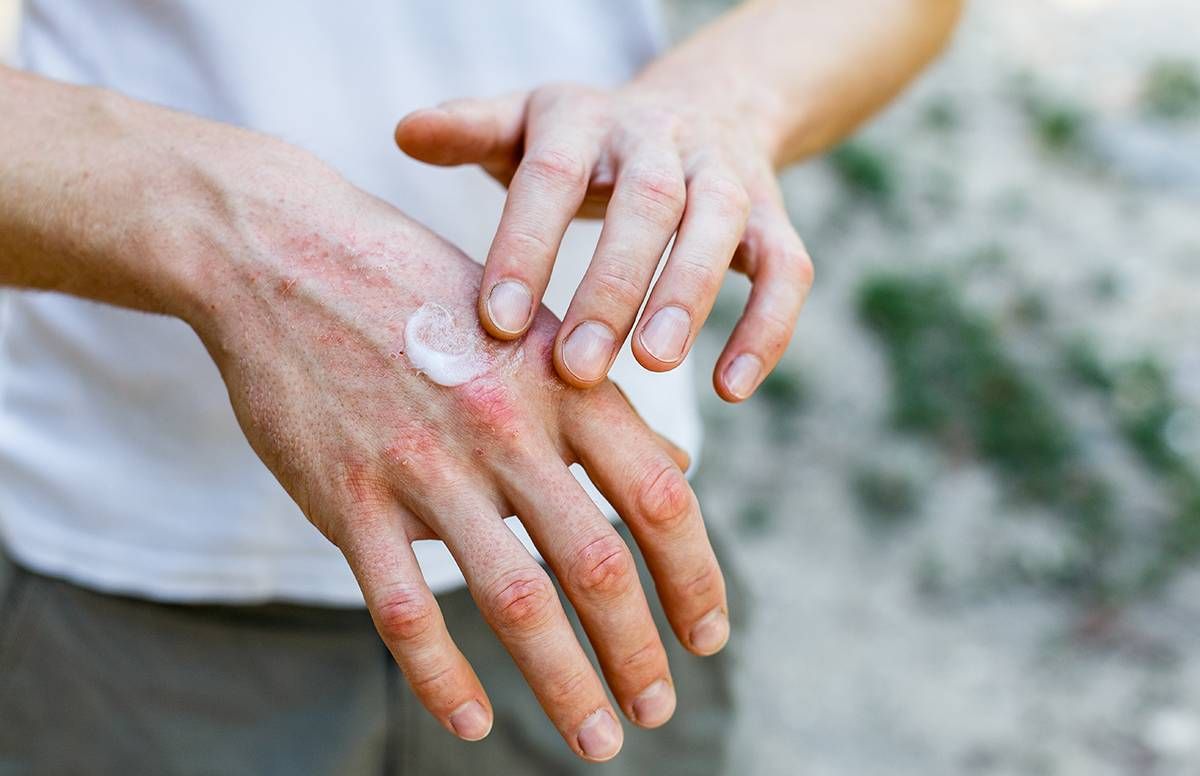What You Need to Know About Adult Eczema
How to treat the skin condition that's increasing in adults 60+
During our hot, muggy, undeniably strange summer, I'd been sweating and scratching. Finally, unable to sleep because of the itching, I masked up and went to the dermatologist. The diagnosis? Eczema, also referred to as atopic dermatitis.

What? I thought only babies got eczema. Actually, according to the National Eczema Association, about 16.5 million American adults have the skin condition. And new onset atopic dermatitis in adults 60+ is increasing, with the peak age for adult onset between 51 and 64. Studies show that some people with adult eczema actually had eczema in childhood, thought they’d outgrown it and had no further symptoms until becoming middle-aged or older.
Understanding Adult Eczema
Atopic dermatitis is a chronic inflammatory skin condition characterized by irritated, reddened, bumpy or scaly patches of skin, and severe pruritis or itching. Many eczema sufferers have a personal or family history of asthma, allergic rhinitis or food allergies.
According to a 2019 article in the British Journal of Dermatology, age-related changes which contribute to the development of atopic dermatitis in older adults include pruritus, xerosis (dry skin), skin barrier changes, immune system disruption and increased risk of bacterial infections.

Early diagnosis and treatment are particularly important in older people of color.
The top layer of skin becomes thinner and less able to retain moisture. There may be increased sensitivity to pollens, dust mites and other environmental triggers, as well as to fragrances and metals such as nickel and cobalt. Atopic dermatitis in older people may appear in different locations (face, neck, body) while sparing areas such as the insides of elbows and backs of knees.
“Because there are other medical conditions in older adults which can present with rashes, scaly red patches, plaques or itchy skin, it is very important to have the diagnosis of atopic dermatitis verified,” says Dr. Andrew Alexis, director of Mt. Sinai’s Skin of Color Center and professor of dermatology at the Icahn School of Medicine at Mount Sinai in New York City.
Adult Eczema in Older People of Color
Early diagnosis and treatment are particularly important in older people of color. Because of decreased skin barrier function, Alexis points out, these patients tend to have more severe flare-ups, with intense itching and poorer quality of life. Patients with darker skin experience more pigmentary changes, with skin thickened from chronic scratching appearing darker than surrounding skin. Prolonged use of topical steroids can lead to hypopigmentation (patches of skin that are lighter than your overall skin tone).
“Atopic dermatitis can have different visual manifestations and immunologic patterns across the spectrum of racial tones,” explains Alexis. “Rather than fire-engine red, lesions and rashes in richly pigmented skin appear grayish, violet or reddish brown. In people of African descent, the morphology (appearance and structure) may be multiple isolated follicular papules (skin lesions) or (the skin disease of) prurigo nodularis, with the presence of firm, raised, intensely itchy bumps.”
Diffuse areas of dry skin and dark undereye circles are more often seen in African American patients with atopic dermatitis than in those with lighter skin.
Atopic dermatitis has unique immunologic characteristics in Asians, who often experience clearly demarcated lesions, prominent scaling, increased thickening and a leathery feel to skin (known as lichenification).
Alexis says emerging research suggests that atopic dermatitis, which presents differently in East Asians, may have some overlap with psoriasis, another skin condition that causes red, itchy scaly patches. Sometimes, he says, the lesions can be hard to differentiate from ones seen in psoriasis.
Living With Atopic Dermatitis
For eczema sufferers, the frequent, severe itching and unpredictability of flare-ups is frustrating. It can be hard to sleep and the sometimes disfiguring or unattractive lesions can cause self-consciousness, leading to social withdrawal and higher than normal incidences of anxiety and depression.

“Years ago I scratched so much that I had constant sores on my hands, feet and legs, but things are much better now."
Ellen Scheib of Fort Lauderdale, Fla., a 64-year-old medical transcriptionist, developed a severe case of atopic dermatitis at 45. It started with a patch on her forehead, spread rapidly to other areas of her body, and at times, she says, “I was covered with bleeding, oozing lesions from my neck to my toes.”
For years, she underwent skin biopsies and hospitalizations, receiving differing diagnoses and becoming increasingly discouraged. Periods of fewer flare-ups were followed by a resurgence of symptoms.
After finally receiving a definitive diagnosis of atopic dermatitis, she began injections of a novel biologic drug (Dupilumab) every other week and things dramatically improved. For the first time in decades, she has weathered the hot Florida sun in shorts, sleeveless shirts and bathing suits.
“It has been a strange summer, but I feel like this medication has given me a life again,” Scheib says.

Writer Willard Hine, 61, of Houston, developed atopic dermatitis at 42. After trying numerous treatments over the years, Hine has developed a care regimen which keeps his eczema in check.
After his daily shower with hypoallergenic body wash, he slathers himself with moisturizing lotion and applies over-the-counter or prescription creams to inflamed areas. When his skin is particularly irritated — and he’s never been able to pinpoint a trigger — he finds calamine lotion or witch hazel soothing.
Hine also takes a daily antihistamine, uses a dehumidifier and soaks in a weekly lukewarm bath with colloidal oatmeal or baking soda.
“Years ago, I scratched so much that I had constant sores on my hands, feet and legs, but things are much better now," he says. "My routines definitely help. I feel good and am managing everything well.”
Treatment for Adult Eczema
Dermatologists emphasize that moisturizing twice a day with one of the many over-the-counter (OTC) emollient lotions or creams is the cornerstone of eczema treatment, along with the application of nonsteroidal creams to inflamed lesions or flared areas of the body.
Corticosteroid ointment, either OTC or prescription strength, should be used judiciously and for no longer than one to two weeks at a time. Antihistamines help to relieve itch.
For serious flare-ups, oral medications such as Prednisone are used to reduce inflammation. Topical calcineurin inhibitors (TCIs), which are steroid-free medications that affect specific cells of the immune system, help lessen redness, itch and swelling.
Another class of topical medication, known as PDE4 inhibitors, block an enzyme linked to inflammation. For very severe cases of atopic dermatitis, systemic immunosuppressant drugs may be used.
Because older adults tend to have comorbidities — multiple medical conditions — these powerful medications must be used with caution. Phototherapy (exposure to UVA or UVB light) is also useful.
Dupilumab (brand name: Dupixent), the first injectable biologic drug approved for moderate to severe eczema, blocks the actions of key substances involved in the inflammatory process and also influences nerves in the skin, reducing the perception of itch. Alexis says it's a very safe and effective drug that typically works well in older people, with few or no side effects.
Eucrisa (crisaborole) is a steroid-free targeted drug for mild-to-moderate eczema that works both above and below the skin.
Living with a chronic disorder, people with atopic dermatitis must become experts on their own bodies, recognizing and avoiding triggers, managing stress and learning to treat flares quickly.
Scheib is one of many so-called “Eczema Ambassadors,” working online as part of the National Eczema Association, which provides resources, support and advocacy to people living with the condition.
“People often need assistance in accessing and understanding information about eczema,” she says. “I am passionate about helping others and making a difference in their lives.”


